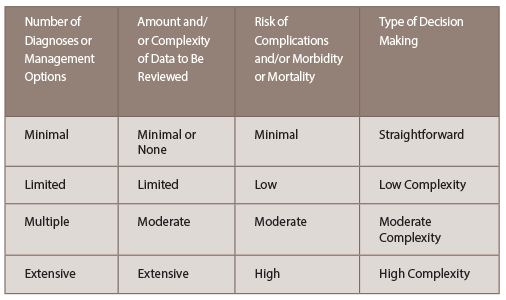
Rawpixel.com/shutterstock.com
The Medical Decision Making (MDM) of an evaluation and management (E/M) visit is one of the three components of determining the level of a patient’s visit. But the MDM can sometimes be the most difficult component, as this is where the provider’s thought process is quantified in deciding the correct level of E/M service. In the American Medical Association Current Procedural Terminology (CPT) manual, the level of complexity of MDM is considered to be a function of three variables, which are also reflected in the Centers for Medicare & Medicaid Services (CMS) Documentation Guidelines for Evaluation and Management Services:
- The number of possible diagnoses and/or the number of management options that must be considered;
- The amount and/or complexity of medical records, diagnostic tests and/or other information that must be obtained, reviewed and analyzed; and
- The risk of significant complications, morbidity and/or mortality, as well as comorbidities associated with the patient’s presenting problem(s), the diagnostic procedure(s), and/or the possible management options.
The levels of the MDM are straightforward, low complexity, moderate complexity and high complexity. What makes it difficult for providers is that not much guidance has been provided as to how to identify the different elements or what makes up the difference between each level. Additionally, another thing that makes it difficult to determine is that to arrive at a particular level, providers and coders have to consider four categories, and within the table there are four corresponding types. To qualify for a level of MDM, the highest two of three elements must be met. In other words, one element does not equal your level of MDM. Often, the code selection is based solely on the risk of complications; however, keep in mind the other two elements play a role in determining the level of MDM. The level of MDM is determined by the table below:

Number of Diagnoses or Management Options
This element is based on the number and types of problems, and the complexity of establishing a diagnosis, along with the management option that the rheumatologist will determine during the course of that visit. Because an established diagnosis that is not worsening would generally require fewer tests and data to review, it would be considered less complicated. A new problem, or a problem that is worsening, would require more work and, therefore, would be more complicated. Below are the documentation guidelines from the Evaluation and Management Services Guide:
- Documentation guideline: For each encounter, an assessment, clinical impression or diagnosis should be documented. It may be explicitly stated or implied in documented decisions regarding management plans and/or further evaluation.
- For a presenting problem with an established diagnosis, the record should reflect whether the problem is: a) improved, well controlled, resolving or resolved; or b) inadequately controlled, worsening or failing to change as expected.
- For a presenting problem without an established diagnosis, the assessment or clinical impression may be stated in the form of a differential diagnoses or as “possible,” “probable” or “rule out” diagnoses.
- Documentation guideline: The initiation of, or changes in, treatment should be documented. Treatment includes a wide range of management options, including patient instructions, nursing instructions, therapies and medications.
- Documentation guideline: If referrals are made, consultations requested or advice sought, the record should indicate to whom or where referral or consultation is made or from whom the advice is requested.
Amount & Complexity of Data to Be Reviewed
This element is based on the number of tests and X-rays that are requested and/or reviewed. The decision to acquire and review past medical records or obtain the patient’s history from a source other than the patient will also increase the level of the amount of complexity of data to be reviewed. This may include a physician having a discussion of unpredicted test results with the physician who performed or interpreted the test, or the physician who ordered the test may actually review the image, tracing or specimen and add information for the physician who prepared the test report or interpretation. Below are the documentation guidelines from the Evaluation and Management Services Guide:
- Documentation guideline: If a diagnostic service (test or procedure) is ordered, planned, scheduled or performed at the time of the E/M encounter, the type of service (e.g., lab or X-ray), should be documented.
- Documentation guideline: The review of lab, radiology and/or diagnostic tests should be documented. An entry in a progress note, such as “WBC elevated” or “chest X-ray unremarkable,” is acceptable. Alternatively, the review may be documented by initialing and dating the report containing the test results.
- Documentation guideline: A decision to obtain old records or decision to obtain additional history from the family, caretaker or other source to supplement that obtained from the patient should be documented.
- Documentation guideline: Relevant finding from the review of old records and/or the receipt of additional history from the family, caretaker or other source should be documented. If there is no relevant information beyond that already obtained, that fact should be documented. A notation of “old records reviewed” or “additional history obtained from family” without elaboration is insufficient.
- Documentation guideline: The results of discussion of laboratory, radiology or other diagnostic tests with the physician who performed or interpreted the study should be documented.
- Documentation guideline: The direct visualization and independent interpretation of an image, tracing or specimen previously or subsequently interpreted by another physician should be documented.
Risk of Significant Complications, Morbidity & Mortality
This element is based on the risks related with the presenting problem, diagnostic procedures, and different management options. Below are the documentation guidelines from the Evaluation and Management Services Guide:
- Documentation guideline: Comorbidities/underlying diseases or other factors that increase the complexity of medical decision making by increasing the risk of complications, morbidity and/or mortality should be documented.
- Documentation guideline: If a surgical or invasive diagnostic procedure is performed at the time of the E/M encounter, the type of procedure (e.g., laparoscopy) should be documented.
- Documentation guideline: If a surgical or invasive diagnostic procedure is performed at the time of the E/M encounter, the specific procedure should be documented.
- Documentation guideline: The referral or decision to perform a surgical or invasive diagnostic procedure on an urgent basis should be documented or implied.
Medical decision making does play a key role in determining the final level to bill for a patient encounter. There are many concerns for providers and coders when it comes to medical decision making, especially when Medicare’s Documentation Guidelines for Evaluation and Management Services are more striking for what they leave unsaid. Many auditors believe that the MDM is what drives the E/M level. Arriving at the final result of an encounter involves many layers, so it is extremely important to document everything that is done during a visit; remember, if it is not documented, it is not billable.
